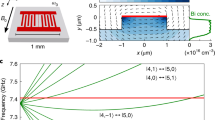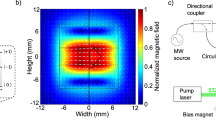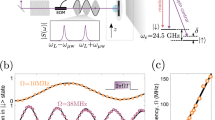Abstract
Spontaneous emission of radiation is one of the fundamental mechanisms by which an excited quantum system returns to equilibrium. For spins, however, spontaneous emission is generally negligible compared to other non-radiative relaxation processes because of the weak coupling between the magnetic dipole and the electromagnetic field. In 1946, Purcell realized1 that the rate of spontaneous emission can be greatly enhanced by placing the quantum system in a resonant cavity. This effect has since been used extensively to control the lifetime of atoms and semiconducting heterostructures coupled to microwave2 or optical3,4 cavities, and is essential for the realization of high-efficiency single-photon sources5. Here we report the application of this idea to spins in solids. By coupling donor spins in silicon to a superconducting microwave cavity with a high quality factor and a small mode volume, we reach the regime in which spontaneous emission constitutes the dominant mechanism of spin relaxation. The relaxation rate is increased by three orders of magnitude as the spins are tuned to the cavity resonance, demonstrating that energy relaxation can be controlled on demand. Our results provide a general way to initialize spin systems into their ground state and therefore have applications in magnetic resonance and quantum information processing6. They also demonstrate that the coupling between the magnetic dipole of a spin and the electromagnetic field can be enhanced up to the point at which quantum fluctuations have a marked effect on the spin dynamics; as such, they represent an important step towards the coherent magnetic coupling of individual spins to microwave photons.
This is a preview of subscription content, access via your institution
Access options
Subscribe to this journal
Receive 51 print issues and online access
$199.00 per year
only $3.90 per issue
Buy this article
- Purchase on Springer Link
- Instant access to full article PDF
Prices may be subject to local taxes which are calculated during checkout




Similar content being viewed by others
References
Purcell, E. M. Spontaneous emission probabilities at radio frequencies. Phys. Rev. 69, 681 (1946)
Goy, P., Raimond, J. M., Gross, M. & Haroche, S. Observation of cavity-enhanced single-atom spontaneous emission. Phys. Rev. Lett. 50, 1903–1906 (1983)
Heinzen, D. J., Childs, J. J., Thomas, J. E. & Feld, M. S. Enhanced and inhibited visible spontaneous emission by atoms in a confocal resonator. Phys. Rev. Lett. 58, 1320–1323 (1987)
Yamamoto, Y., Machida, S., Horikoshi, Y., Igeta, K. & Bjork, G. Enhanced and inhibited spontaneous emission of free excitons in GaAs quantum wells in a microcavity. Opt. Commun. 80, 337–342 (1991)
Gérard, J. M. et al. Enhanced spontaneous emission by quantum boxes in a monolithic optical microcavity. Phys. Rev. Lett. 81, 1110–1113 (1998)
Butler, M. C. & Weitekamp, D. P. Polarization of nuclear spins by a cold nanoscale resonator. Phys. Rev. A 84, 063407 (2011)
Sinova, J. & Žutić, I. New moves of the spintronics tango. Nature Mater. 11, 368–371 (2012)
Ladd, T. D. et al. Quantum computers. Nature 464, 45–53 (2010)
Levitt, M. H. Spin Dynamics: Basics of Nuclear Magnetic Resonance (John Wiley & Sons, 2001)
Robledo, L. et al. High-fidelity projective read-out of a solid-state spin quantum register. Nature 477, 574–578 (2011)
Pla, J. J. et al. A single-atom electron spin qubit in silicon. Nature 489, 541–545 (2012)
Shapiro, M. G. et al. Directed evolution of a magnetic resonance imaging contrast agent for noninvasive imaging of dopamine. Nature Biotechnol. 28, 264–270 (2010)
Wood, C. J., Borneman, T. W. & Cory, D. G. Cavity cooling of an ensemble spin system. Phys. Rev. Lett. 112, 050501 (2014)
Sleator, T., Hahn, E. L., Hilbert, C. & Clarke, J. Nuclear-spin noise. Phys. Rev. Lett. 55, 1742–1745 (1985)
Hahn, E. Spin echoes. Phys. Rev. 80, 580–594 (1950)
Zhou, X. et al. High-gain weakly nonlinear flux-modulated Josephson parametric amplifier using a SQUID array. Phys. Rev. B 89, 214517 (2014)
Bienfait, A. et al. Reaching the quantum limit of sensitivity in electron spin resonance. Nature Nanotechnol. http://dx.doi.org/10.1038/nnano.2015.282 (2015)
Feher, G. Electron spin resonance experiments on donors in silicon. I. Electronic structure of donors by the electron nuclear double resonance technique. Phys. Rev. 114, 1219–1244 (1959)
Wolfowicz, G. et al. Decoherence mechanisms of 209 Bi donor electron spins in isotopically pure 28Si. Phys. Rev. B 86, 245301 (2012)
Morley, G. W. et al. The initialization and manipulation of quantum information stored in silicon by bismuth dopants. Nature Mater. 9, 725–729 (2010)
George, R. E. et al. Electron spin coherence and electron nuclear double resonance of Bi donors in natural Si. Phys. Rev. Lett. 105, 067601 (2010)
Schweiger, A. & Jeschke, G. Principles of Pulse Electron Paramagnetic Resonance 225 (Oxford Univ. Press, 2001)
Feher, G. & Gere, E. A. Electron spin resonance experiments on donors in silicon. II. Electron spin relaxation effects. Phys. Rev. 114, 1245–1256 (1959)
Bloembergen, N. & Pound, R. V. Radiation damping in magnetic resonance experiments. Phys. Rev. 95, 8–12 (1954)
Wood, C. J. & Cory, D. G. Cavity cooling to the ground state of an ensemble quantum system. Preprint at http://arXiv.org/abs/1506.03007 (2015)
Feher, G., Gordon, J. P., Buehler, E., Gere, E. A. & Thurmond, C. D. Spontaneous emission of radiation from an electron spin system. Phys. Rev. 109, 221–222 (1958)
Temnov, V. V. & Woggon, U. Superradiance and subradiance in an inhomogeneously broadened ensemble of two-level systems coupled to a low-Q cavity. Phys. Rev. Lett. 95, 243602 (2005)
Carver, T. R. & Slichter, C. P. Polarization of nuclear spins in metals. Phys. Rev. 92, 212–213 (1953)
Abragam, A. & Goldman, M. Principles of dynamic nuclear polarisation. Rep. Prog. Phys. 41, 395–467 (1978)
Bloembergen, N., Shapiro, S., Pershan, P. S. & Artman, J. O. Cross-relaxation in spin systems. Phys. Rev. 114, 445–459 (1959)
Wolfowicz, G. et al. Atomic clock transitions in silicon-based spin qubits. Nature Nanotechnol. 8, 561–564 (2013)
Van Duzer, T. & Turner, C. W. Principles of Superconductive Devices and Circuits 2nd edn (Prentice-Hall PTR, 1999)
Palacios-Laloy, A. Superconducting Qubit in a Resonator: Test of the Leggett-Garg Inequality and Single-shot Readout. PhD thesis, Université Pierre et Marie Curie — Paris VI (2010)
Mentink-Vigier, F. et al. Increasing sensitivity of pulse EPR experiments using echo train detection schemes. J. Magn. Reson. 236, 117–125 (2013)
Bloembergen, N. On the interaction of nuclear spins in a crystalline lattice. Physica 15, 386–426 (1949)
Abragam, A. Principles of Nuclear Magnetism Ch. IX (Oxford Univ. Press, 1983)
de Graaf, S. E., Davidovikj, D., Adamyan, A., Kubatkin, S. E. & Danilov, A. V. Galvanically split superconducting microwave resonators for introducing internal voltage bias. Appl. Phys. Lett. 104, 052601 (2014)
Wisby, I. et al. Coupling of a locally implanted rare-earth ion ensemble to a superconducting micro-resonator. Appl. Phys. Lett. 105, 102601 (2014)
Samkharadze, N. et al. High kinetic inductance superconducting nanowire resonators for circuit QED in a magnetic field. Preprint at http://arXiv.org/abs/1511.01760 (2015)
Can, T. V. et al. Overhauser effects in insulating solids. J. Chem. Phys. 141, 064202 (2014)
Acknowledgements
We acknowledge technical support from P. Sénat, D. Duet, J.-C. Tack, P. Pari and P. Forget, as well as discussions within the Quantronics group. We acknowledge support of the European Research Council under the European Community’s Seventh Framework Programme (FP7/2007-2013) through grant agreements No. 615767 (CIRQUSS), 279781 (ASCENT) and 630070 (quRAM), and of the C’Nano IdF project QUANTROCRYO. J.J.L.M. is supported by the Royal Society. C.C.L. is supported by the Royal Commission for the Exhibition of 1851. T.S. and C.D.W. were supported by the US Department of Energy under contract DE-AC02-05CH11231.
Author information
Authors and Affiliations
Contributions
A.B., J.J.P., J.J.L.M. and P.B. designed the experiment. X.Z. and D.V. designed and fabricated the Josephson Parametric Amplifier. C.C.L., C.D.W. and T.S. provided the bismuth-implanted isotopically purified silicon sample. A.B., J.J.P. and Y.K. fabricated the sample and performed the measurements. A.B., J.J.P., Y.K., J.J.L.M. and P.B. analysed the data. J.J.L.M., D.E., D.V. and P.B. supervised the project. A.B., J.J.P., Y.K., M.S., D.V., D.E., J.J.L.M. and P.B. contributed to writing the paper.
Corresponding author
Ethics declarations
Competing interests
The authors declare no competing financial interests.
Extended data figures and tables
Extended Data Figure 1 Effect of excitation-pulse bandwidth on the measurement of T1.
a, The red and blue lines shown the computed pulse bandwidth (‘normalized response’) for a 5-μs π pulse and a 100-μs π pulse, respectively, incident on a cavity with κ/(2π) = 23 kHz (green dashes). To illustrate the averaging effect of the pulse bandwidth on T1 measurements, the expected Purcell T1 curve (black line) as a function of spin–cavity detuning is plotted on the right axis, with T1(0) = 0.35 s and κ/(2π) = 23 kHz. b, T1 measurements for two different π-pulse lengths (see insets), measured on resonance with resonator A. Spin polarization is measured with a Hahn echo sequence and AQ is rescaled by its value for T ≫T1 (‘AQ(T = ∞)’). Symbols are data and solid lines are exponential fits. The 100-μs π pulse (blue) yields T1 = 0.35 s, which is in agreement with the Purcell rate. The 5-μs π pulse (red) yields T1 = 0.65 s, a factor of two greater than the accurate value.
Extended Data Figure 2 Spectral spin diffusion.
a–c, T1 measurement sequence when spins are detuned from the cavity by applying a magnetic field Bδ , providing a detuning of δ = ωs − ω0 = 2πγeffBδ , with γeff = df/dB(B0) the effective gyromagnetic ratio, evaluated as the derivative of f = 2πωs with respect to the applied magnetic field B at a given magnetic field B0. In a, a 5-μs π pulse is used to realize an inversion-recovery sequence; in b, a 1-s-long strong microwave pulse sent at cavity resonance is used to realize a saturation-recovery sequence; in c, a magnetic field scan (bottom panel) is used in addition to a 6-s-long strong microwave pulse to realize a saturation-recovery sequence. The expected magnetic field profile due to the coil filtering, assuming that the coil is an order-one low-pass filter with a bandwidth of 1 Hz, is shown in orange (c, bottom panel). d, T1 measurements for sequences shown in a (green), b (red) and c (blue) for δ/(2π) = 3.8 MHz. The fits (black lines) to the green and red data have a double-exponential decay, whereas the fit to the blue data is a simple exponential. We attribute the double-exponential decay (with extracted characteristic times T1A and T1B) to spin diffusion. e, Spectral profiles of the excitation pulse sequences shown in a (green), b (red) and c (blue). The sequence is as follows: send the excitation pulse, detune the spins and measure AQ(ωs). The black line is the reference profile without any excitation pulse, yielding the reference polarization  . When an excitation pulse is sent, we can access
. When an excitation pulse is sent, we can access  . To conserve the line shape profile, we plotted AQ(ωs)/AQ0(ω0) instead of AQ(ωs)/AQ0(ωs). Neither the π profile nor the saturation profiles reach the full inversion +1 or the full saturation 0 at resonance; this is an artefact due to the coil transient time.
. To conserve the line shape profile, we plotted AQ(ωs)/AQ0(ω0) instead of AQ(ωs)/AQ0(ωs). Neither the π profile nor the saturation profiles reach the full inversion +1 or the full saturation 0 at resonance; this is an artefact due to the coil transient time.
Rights and permissions
About this article
Cite this article
Bienfait, A., Pla, J., Kubo, Y. et al. Controlling spin relaxation with a cavity. Nature 531, 74–77 (2016). https://doi.org/10.1038/nature16944
Received:
Accepted:
Published:
Issue Date:
DOI: https://doi.org/10.1038/nature16944
This article is cited by
-
Single-electron spin resonance detection by microwave photon counting
Nature (2023)
-
Lamb shift statistics in mesoscopic quantum ensembles
Quantum Information Processing (2022)
-
Review of noble-gas spin amplification via the spin-exchange collisions
Science China Information Sciences (2022)
-
Quantum guidelines for solid-state spin defects
Nature Reviews Materials (2021)
-
Semiconductor qubits in practice
Nature Reviews Physics (2021)
Comments
By submitting a comment you agree to abide by our Terms and Community Guidelines. If you find something abusive or that does not comply with our terms or guidelines please flag it as inappropriate.



